Analysis of the Spatiotemporal Differentiation and Influencing Factors of Land Use Efficiency in the Beijing–Tianjin–Hebei Urban Agglomeration
Abstract
:1. Introduction
2. Study Area and Datasets
2.1. Overview of the Study Region
2.2. Data Sources
3. Analysis Method
3.1. ULUE Evaluation Index System
3.2. SBM-DEA Model
3.3. Exploratory Spatial Data Analysis
3.4. Efficiency Evolution Analysis
3.5. Geographical Detector
4. Results and Analysis
4.1. Spatial Temporal Analysis of Land Use Changes in BTH Urban Agglomeration
4.1.1. Temporal Evolution Characteristics
4.1.2. Spatial Evolution Characteristics
4.2. Spatial Agglomeration Characteristics of Urban ULUE
4.3. Spatial Evolution Characteristics of Urban Land Use Decomposition Efficiency
4.4. Geographical Detector
4.4.1. Factor Detection and Result Analysis
4.4.2. Interaction Detection Results and Analysis
5. Discussion
5.1. Conclusions
5.2. Theorical Implications
5.3. Practical Implications
5.4. Limitations and Future Research
Author Contributions
Funding
Data Availability Statement
Conflicts of Interest
References
- Ramachandra, T.V.; Aithal, B.H.; Sanna, D.D. Insights to Urban Dynamics through Landscape Spatial Pattern Analysis. Int. J. Appl. Earth Obs. Geoinf. 2012, 18, 329–343. [Google Scholar] [CrossRef]
- Zou, L.; Liu, Y.; Wang, J.; Yang, Y.; Wang, Y. Land Use Conflict Identification and Sustainable Development Scenario Simulation on China’s Southeast Coast. J. Clean. Prod. 2019, 238, 117899. [Google Scholar] [CrossRef]
- Dong, G.; Liu, Z.; Niu, Y.; Jiang, W. Identification of Land Use Conflicts in Shandong Province from an Ecological Security Perspective. Land 2022, 11, 2196. [Google Scholar] [CrossRef]
- Chen, D.; Hu, W.; Li, Y.; Zhang, C.; Lu, X.; Cheng, H. Exploring the Temporal and Spatial Effects of City Size on Regional Economic Integration: Evidence from the Yangtze River Economic Belt in China. Land Use Policy 2023, 132, 106770. [Google Scholar] [CrossRef]
- Zhao, J.; Zhu, D.; Cheng, J.; Jiang, X.; Lun, F.; Zhang, Q. Does Regional Economic Integration Promote Urban Land Use Efficiency? Evidence from the Yangtze River Delta, China. Habitat Int. 2021, 116, 102404. [Google Scholar] [CrossRef]
- Jingxin, G.; Jinbo, S.; Lufang, W. A New Methodology to Measure the Urban Construction Land-Use Efficiency Based on the Two-Stage DEA Model. Land Use Policy 2022, 112, 105799. [Google Scholar] [CrossRef]
- Jiang, H. Spatial–Temporal Differences of Industrial Land Use Efficiency and Its Influencing Factors for China’s Central Region: Analyzed by SBM Model. Environ. Technol. Innov. 2021, 22, 101489. [Google Scholar] [CrossRef]
- Zhang, X.; Jie, X.; Ning, S.; Wang, K.; Li, X. Coupling and Coordinated Development of Urban Land Use Economic Efficiency and Green Manufacturing Systems in the Chengdu-Chongqing Economic Circle. Sustain. Cities Soc. 2022, 85, 104012. [Google Scholar] [CrossRef]
- Bardo, J.W.; Hartman, J.J. Urban Sociology: A Systematic Introduction; F.E. Peacock: Itasca, IL, USA, 1982. [Google Scholar]
- Koopmans, T.C.; Beckmann, M.J. Assignment Problems and the Location of Economic Activities. Econometrica 1957, 25, 53. [Google Scholar]
- Wheaton, W.C. Urban Residential Growth under Perfect Foresight. J. Urban Econ. 1982, 12, 1–21. [Google Scholar] [CrossRef]
- Capozza, D.R.; Helsley, R.W. The Fundamentals of Land Prices and Urban Growth. J. Urban Econ. 1989, 26, 295–306. [Google Scholar] [CrossRef]
- Fava, S.F.; Chapin, F.S. Urban Land Use Planning. Am. Sociol. Rev. 1957, 22, 765. [Google Scholar]
- Scott, A.J. The Urban Land Nexus and the State; Routledge: London, UK, 1980. [Google Scholar]
- Russett, B.M. Locational Approaches to Power and Conflict. Am. Political Sci. Rev. 1977, 71, 1617–1618. [Google Scholar]
- Williams, O.P. Urban Politics as Political Ecology; Palgrave Macmillan: London, UK, 1975. [Google Scholar]
- Jenks, M.; Burton, E.J.; Williams, K. The Compact City: A Sustainable Urban Form? Routledge: London, UK, 1996. [Google Scholar]
- Gabriel, S.A.; Faria, J.A.; Moglen, G.E. A Multiobjective Optimization Approach to Smart Growth in Land Development. Socio-Econ. Plan. Sci. 2006, 40, 212–248. [Google Scholar]
- Irwin, E.G. New Directions for Urban Economic Models of Land Use Change: Incorporating Spatial Heterogeneity and Transitional Dynamics. J. Reg. Sci. 2009, 50, 65–91. [Google Scholar]
- Verburg, P.H.; van Berkel, D.B.; van Doorn, A.M.; van Eupen, M.; van den Heiligenberg, H.A.R.M. Trajectories of Land Use Change in Europe: A Model-Based Exploration of Rural Futures. Landsc. Ecol. 2010, 25, 217–232. [Google Scholar] [CrossRef]
- Thornton, P.E.; Calvin, K.; Jones, A.D.; Di Vittorio, A.V.; Bond-Lamberty, B.; Chini, L.; Shi, X.; Mao, J.; Collins, W.D.; Edmonds, J.; et al. Biospheric Feedback Effects in a Synchronously Coupled Model of Human and Earth Systems. Nat. Clim. Change 2017, 7, 496–500. [Google Scholar] [CrossRef]
- Edwards, D.P.; Socolar, J.B.; Mills, S.C.; Burivalova, Z.; Koh, L.P.; Wilcove, D.S. Conservation of Tropical Forests in the Anthropocene. Curr. Biol. 2019, 29, R1008–R1020. [Google Scholar]
- Kaur, H.; Garg, P. Urban Sustainability Assessment Tools: A Review. J. Clean. Prod. 2019, 210, 146–158. [Google Scholar] [CrossRef]
- Zhu, X.; Zhang, P.; Wei, Y.; Li, Y.; Zhao, H. Measuring the Efficiency and Driving Factors of Urban Land Use Based on the DEA Method and the PLS-SEM Model—A Case Study of 35 Large and Medium-Sized Cities in China. Sustain. Cities Soc. 2019, 50, 101646. [Google Scholar] [CrossRef]
- Tone, K.; Tsutsui, M. Dynamic DEA with Network Structure: A Slacks-Based Measure Approach. Omega 2014, 42, 124–131. [Google Scholar] [CrossRef]
- Xie, H.; Wang, W. Exploring the Spatial-Temporal Disparities of Urban Land Use Economic Efficiency in China and Its Influencing Factors under Environmental Constraints Based on a Sequential Slacks-Based Model. Sustainability 2015, 7, 10171–10190. [Google Scholar] [CrossRef]
- Wu, C.; Wei, Y.D.; Huang, X.; Chen, B. Economic Transition, Spatial Development and Urban Land Use Efficiency in the Yangtze River Delta, China. Habitat Int. 2017, 63, 67–78. [Google Scholar] [CrossRef]
- Xie, H.; Chen, Q.; Lu, F.; Wang, W.; Yao, G.; Yu, J. Spatial-Temporal Disparities and Influencing Factors of Total-Factor Green Use Efficiency of Industrial Land in China. J. Clean. Prod. 2019, 207, 1047–1058. [Google Scholar] [CrossRef]
- Yuan, X.; Liu, R.; Huang, T. Analyzing Spatial–Temporal Patterns and Driving Mechanisms of Ecological Resilience Using the Driving Force–Pressure–State–Influence–Response and Environment–Economy–Society Model: A Case Study of 280 Cities in China. Systems 2024, 12, 311. [Google Scholar] [CrossRef]
- Kuang, B.; Lu, X.; Zhou, M.; Chen, D. Provincial Cultivated Land Use Efficiency in China: Empirical Analysis Based on the SBM-DEA Model with Carbon Emissions Considered. Technol. Forecast. Soc. Change 2020, 151, 119874. [Google Scholar] [CrossRef]
- Fu, Y.; Zhou, T.; Yao, Y.; Qiu, A.; Wei, F.; Liu, J.; Liu, T. Evaluating Efficiency and Order of Urban Land Use Structure: An Empirical Study of Cities in Jiangsu, China. J. Clean. Prod. 2021, 283, 124638. [Google Scholar] [CrossRef]
- Seto, K.C.; Fragkias, M.; Güneralp, B.; Reilly, M.K. A Meta-Analysis of Global Urban Land Expansion. PLoS ONE 2011, 6, e23777. [Google Scholar] [CrossRef]
- Paulsen, K. Geography, Policy or Market? New Evidence on the Measurement and Causes of Sprawl (and Infill) in US Metropolitan Regions. Urban Stud. 2014, 51, 2629–2645. [Google Scholar] [CrossRef]
- Xia, J.; Yan, Z.; Zhou, W.; Fong, S.K.; Leong, K.C.; Tang, I.M.; Chang, S.W.; Leong, W.K.; Jin, S. Projection of the Zhujiang (Pearl) River Delta’s Potential Submerged Area Due to Sea Level Rise during the 21st Century Based on CMIP5 Simulations. Acta Oceanol. Sin. 2015, 34, 78–84. [Google Scholar] [CrossRef]
- Masini, E.; Tomao, A.; Barbati, A.; Corona, P.; Serra, P.; Salvati, L. Urban Growth, Land-Use Efficiency and Local Socioeconomic Context: A Comparative Analysis of 417 Metropolitan Regions in Europe. Environ. Manag. 2019, 63, 322–337. [Google Scholar] [CrossRef]
- Gao, X.; Zhang, A.; Sun, Z. How Regional Economic Integration Influence on Urban Land Use Efficiency? A Case Study of Wuhan Metropolitan Area, China. Land Use Policy 2020, 90, 104329. [Google Scholar] [CrossRef]
- Cao, X.; Liu, Y.; Li, T.; Liao, W. Analysis of Spatial Pattern Evolution and Influencing Factors of Regional Land Use Efficiency in China Based on ESDA-GWR. Sci. Rep. 2019, 9, 520. [Google Scholar] [CrossRef]
- Reynès, F. The Cobb–Douglas Function as a Flexible Function: A New Perspective on Homogeneous Functions through the Lens of Output Elasticities. Math. Soc. Sci. 2019, 97, 11–17. [Google Scholar] [CrossRef]
- Liao, X.; Fang, C.; Shu, T.; Ren, Y. Spatiotemporal Impacts of Urban Structure upon Urban Land-Use Efficiency: Evidence from 280 Cities in China. Habitat Int. 2023, 131, 102727. [Google Scholar] [CrossRef]
- Yan, S.; Peng, J.; Wu, Q. Exploring the Non-Linear Effects of City Size on Urban Industrial Land Use Efficiency: A Spatial Econometric Analysis of Cities in Eastern China. Land Use Policy 2020, 99, 104944. [Google Scholar] [CrossRef]
- Bellassen, V.; Luyssaert, S. Carbon Sequestration: Managing Forests in Uncertain Times. Nature 2014, 506, 153–155. [Google Scholar] [CrossRef]
- Hong, J.; Mao, Y. How Does the Green Efficiency of Urban Land Use Evolve in the Urban Agglomeration of China’s Middle Yangtze River? Nat. Resour. Model. 2024, 37, e12392. [Google Scholar] [CrossRef]
- Anselin, L. Local Indicators of Spatial Association—LISA. Geographical Analysis 1995, 27, 93–115. [Google Scholar] [CrossRef]
- Meng, Q.; Pi, H.; Xu, T.; Li, L. Exploring the Relationship between Regional Tourism Development and Land Use Efficiency: A Case Study of Guangxi Zhuang Autonomous Region, China. PLoS ONE 2024, 19, e0297196. [Google Scholar] [CrossRef]
- Lin, Q.; Bai, S.; Qi, R. Cultivated Land Green Use Efficiency and Its Influencing Factors: A Case Study of 39 Cities in the Yangtze River Basin of China. Sustainability 2024, 16, 29. [Google Scholar] [CrossRef]
- Han, D.; Cao, Z. Evaluation and Influential Factors of Urban Land Use Efficiency in Yangtze River Economic Belt. Land 2024, 13, 671. [Google Scholar] [CrossRef]

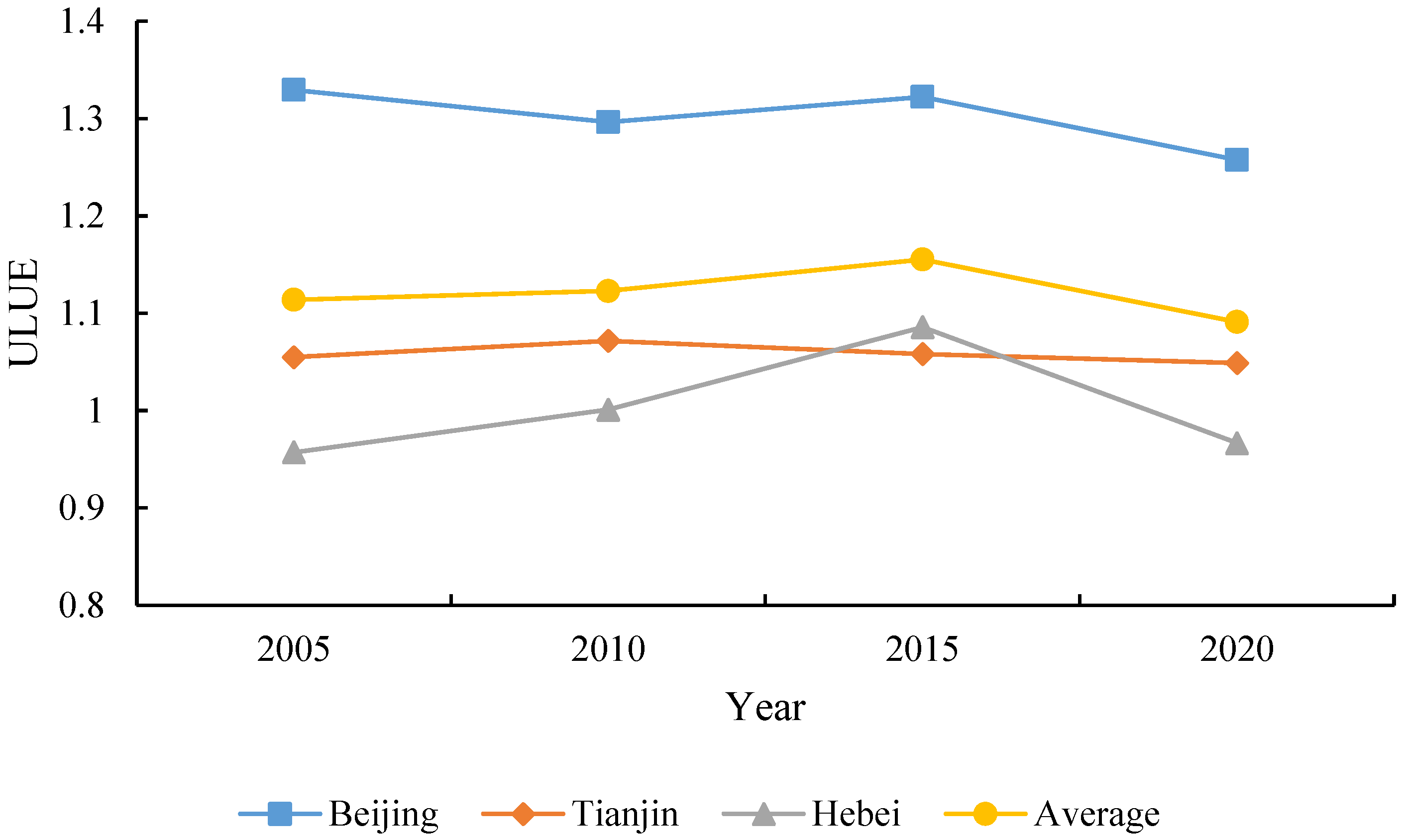
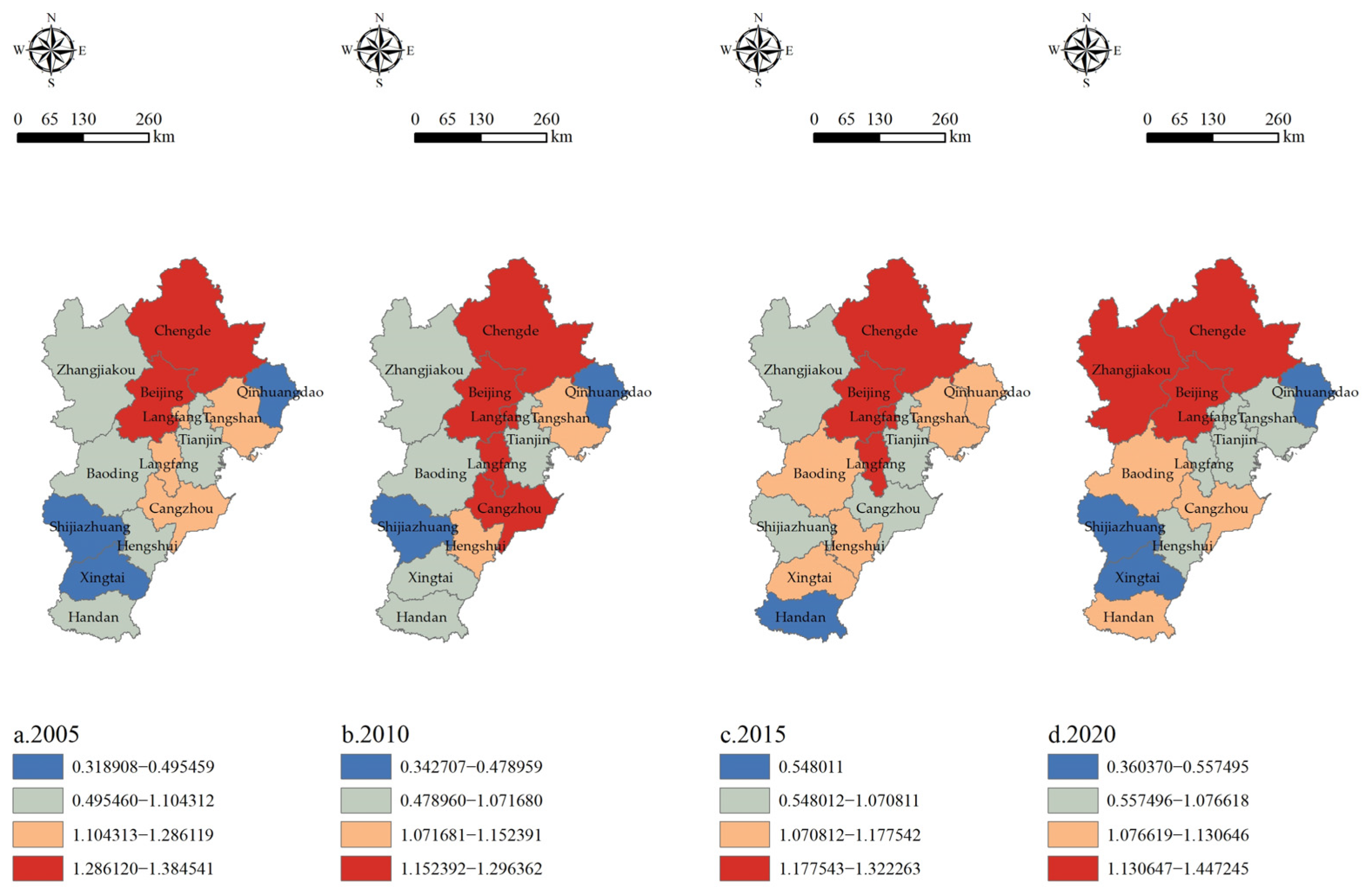
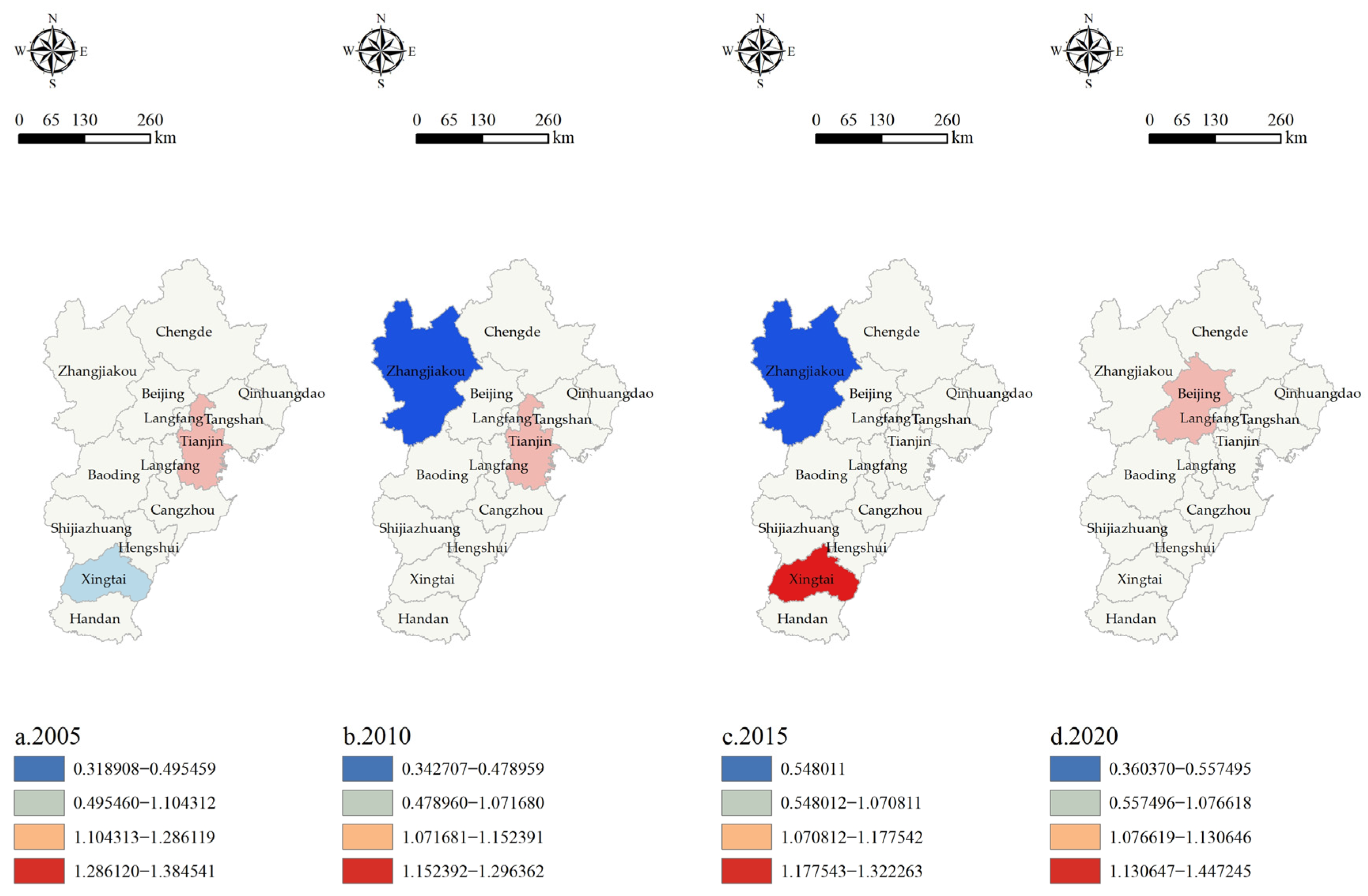
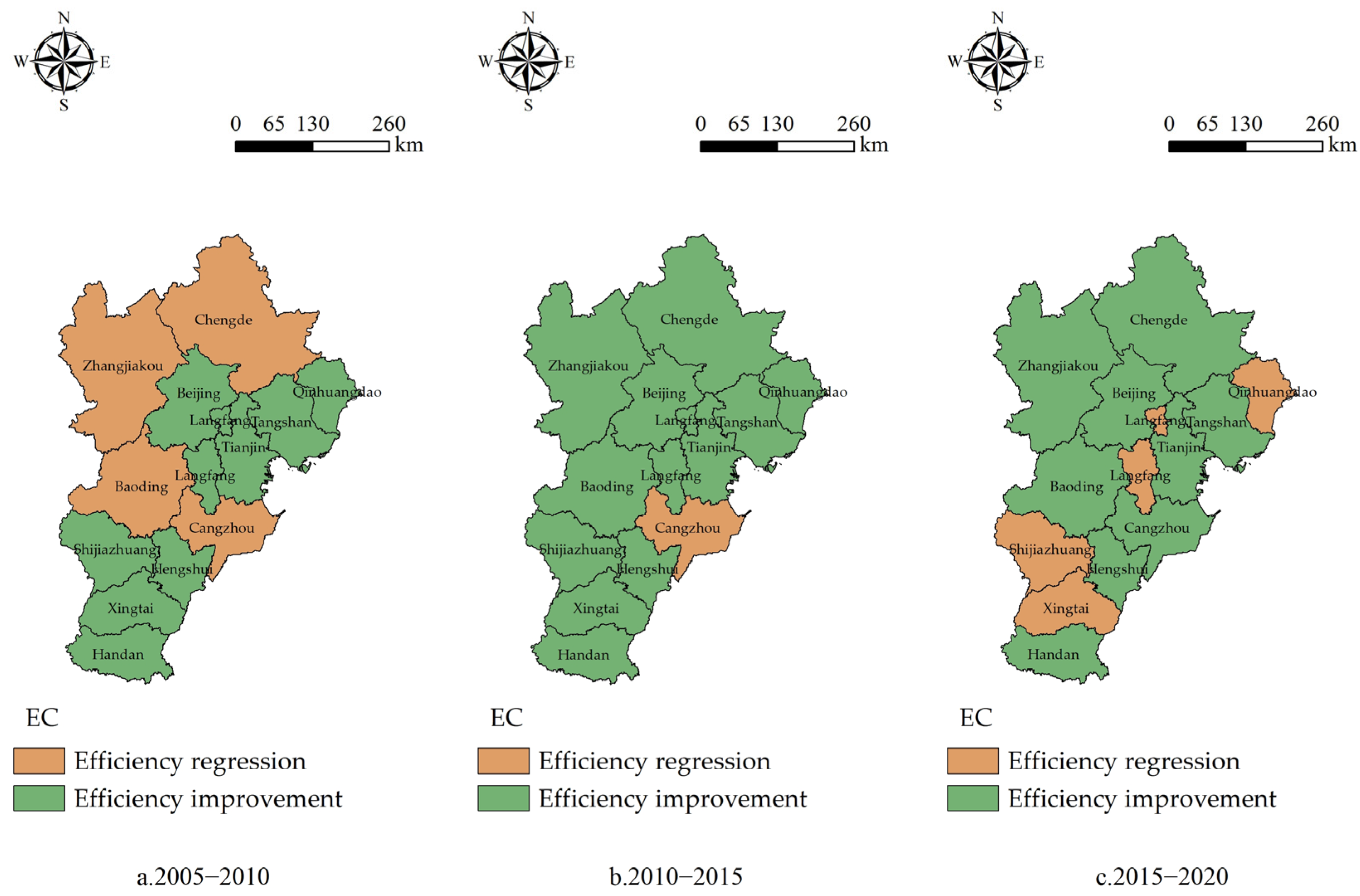

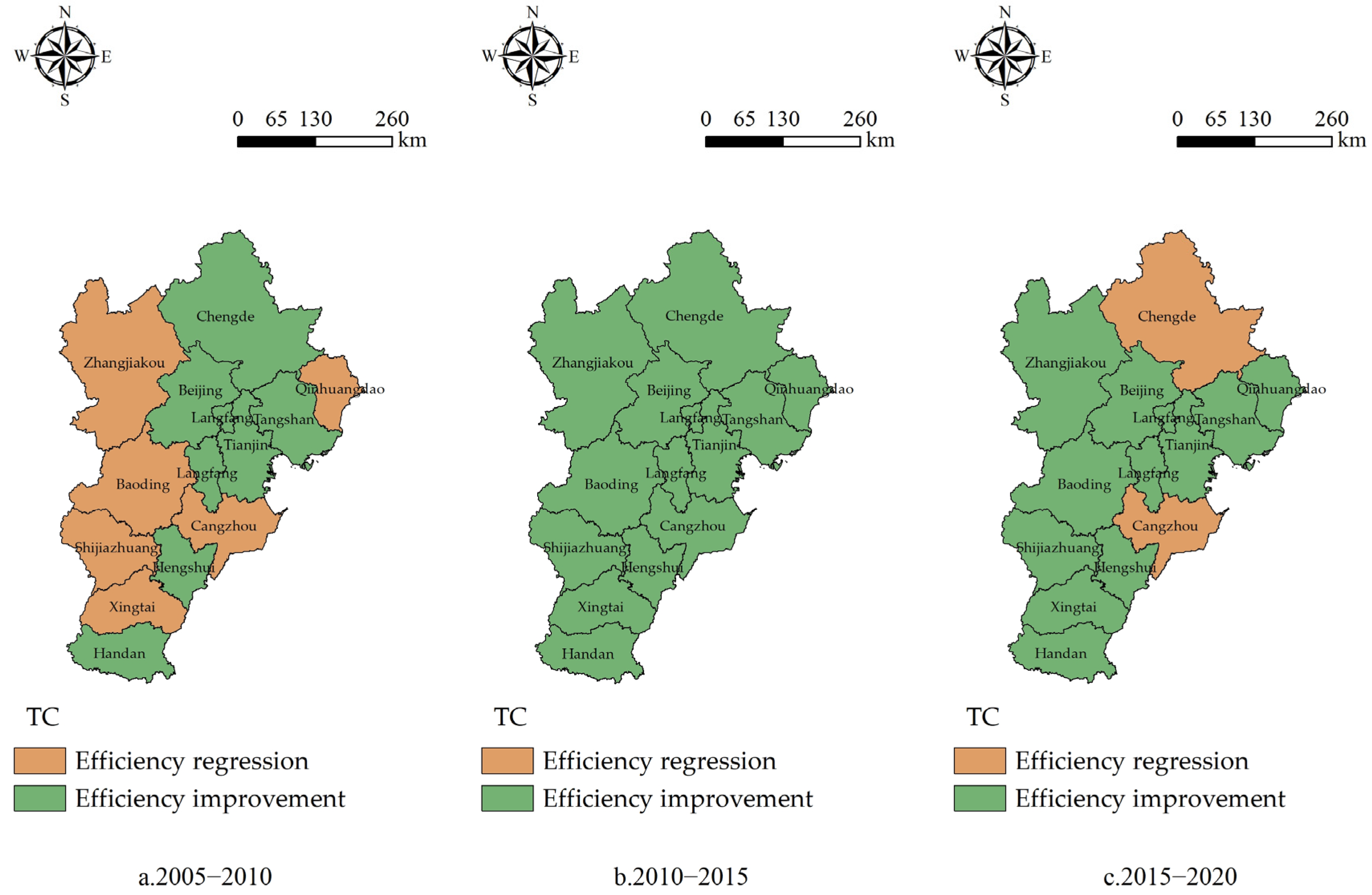

| Primary Indicators | Secondary Indicators | Tertiary Indicators | Calculation Method |
|---|---|---|---|
| Input Indicators | Capital | Fixed Capital Investment Per Unit Land Area (x1) | Total Social Fixed Asset Investment in the Urban Area/Area of the Urban Area |
| Land | Proportion of Built-up Land Area (x2) | Built-up Area of the Urban Area/Area of the Urban Area | |
| Labor | Number of Urban Employees Per Unit Land Area (x3) | Number of Urban Employees/Area of the Urban Area | |
| Desired Outputs | Economic Benefits | GDP Per Unit Land Area (x4) | GDP of the Urban Area/Area of the Urban Area |
| Average Wages of On-the-job Employees (x5) | Total Wages of On-the-job Employees/Number of On-the-job Employees | ||
| Social Welfare | Number of Beds in Public Health Institutions Per Unit Land Area (x6) | Number of Beds in Public Health Institutions in the Urban Area/Area of the Urban Area | |
| Education Level Per Unit Land Area (x7) | Number of Primary and Secondary Schools in the Urban Area/Area of the Urban Area | ||
| Ecological Environment | Per Capita Public Green Area (x8) | Public Green Area in the Urban Area/Total Population of the Urban Area | |
| Green Coverage Rate of Built-up Areas (x9) | Total Green Area in the Urban Area/Area of the Urban Area | ||
| Undesired Outputs | Sewage Discharge | Sewage Discharge Per Unit Land Area (x10) | Sewage Discharge/Area of the Urban Area |
| Carbon Emissions | Carbon Emissions Per Unit Land Area (x11) | Total Carbon Emissions/Area of the Urban Area |
| Judgement Criteria | Interaction Effect |
|---|---|
| Nonlinear weakening | |
| Univariate nonlinear weakening | |
| Bivariate enhancement | |
| Independent | |
| Nonlinear enhancement |
| Year | Global Moran’ I | z-Value | p-Value |
|---|---|---|---|
| 2005 | −0.134 | −1.0041 | 0.116 |
| 2010 | −0.157 | −1.6525 | 0.048 |
| 2015 | 0.016 | 2.4379 | 0.034 |
| 2020 | −0.182 | −1.9430 | 0.012 |
| Area | Cumulative Change Value | Geometric Mean | ||||
|---|---|---|---|---|---|---|
| GML | EC | TC | GML | EC | TC | |
| Beijing | 0.023243 | 0.05835 | 0.050747 | 1.041754 | 1.026142 | 1.061249 |
| Tianjin | −0.03632 | −0.02563 | −0.01072 | 1.04487 | 1.006557 | 1.046793 |
| Shijiazhuang | −0.43522 | −0.60078 | 0.797856 | 1.327282 | 1.154614 | 1.274292 |
| Tangshan | 0.239769 | 0.077758 | 0.19746 | 1.174296 | 0.933307 | 1.254153 |
| Qinhuangdao | −0.17902 | −0.13814 | 1.595069 | 1.453172 | 1.008462 | 1.466284 |
| Handan | 2.012282 | 0.065909 | 0.497505 | 1.518747 | 1.032557 | 1.48238 |
| Xingtai | −0.77352 | −0.14715 | 0.672346 | 1.247653 | 1.009416 | 1.199544 |
| Baoding | 0.057511 | 0.045378 | 0.040746 | 1.122156 | 1.030264 | 1.08913 |
| Zhangjiakou | 0.576365 | 1.346611 | 0.094204 | 1.213028 | 1.287217 | 1.108462 |
| Chengde | 0.035983 | 0.199405 | −0.09262 | 1.094533 | 0.966801 | 1.104921 |
| Cangzhou | 0.04915 | 0.002258 | 0.050815 | 0.992872 | 0.980843 | 1.016284 |
| Langfang | −0.30318 | −0.13193 | −0.07892 | 1.119244 | 0.943493 | 1.183914 |
| Hengshui | −0.02581 | −0.14726 | 0.115111 | 1.187391 | 1.015924 | 1.172685 |
| BTH region | 0.095481 | 0.046522 | 0.302277 | 1.195154 | 1.03043 | 1.189238 |
| x1 | x2 | x3 | x4 | x5 | x6 | x7 | x8 | x9 | |
|---|---|---|---|---|---|---|---|---|---|
| q statistic | 0.7904 | 0.1165 | 0.7761 | 0.6771 | 0.9486 | 0.8764 | 0.3580 | 0.0477 | 0.1246 |
| p value | 0.000 | 0.1151 | 0.000 | 0.000 | 0.000 | 0.000 | 0.2571 | 0.5259 | 0.1360 |
Disclaimer/Publisher’s Note: The statements, opinions and data contained in all publications are solely those of the individual author(s) and contributor(s) and not of MDPI and/or the editor(s). MDPI and/or the editor(s) disclaim responsibility for any injury to people or property resulting from any ideas, methods, instructions or products referred to in the content. |
© 2024 by the authors. Licensee MDPI, Basel, Switzerland. This article is an open access article distributed under the terms and conditions of the Creative Commons Attribution (CC BY) license (https://creativecommons.org/licenses/by/4.0/).
Share and Cite
Huang, H.; Yang, J. Analysis of the Spatiotemporal Differentiation and Influencing Factors of Land Use Efficiency in the Beijing–Tianjin–Hebei Urban Agglomeration. Land 2024, 13, 1508. https://doi.org/10.3390/land13091508
Huang H, Yang J. Analysis of the Spatiotemporal Differentiation and Influencing Factors of Land Use Efficiency in the Beijing–Tianjin–Hebei Urban Agglomeration. Land. 2024; 13(9):1508. https://doi.org/10.3390/land13091508
Chicago/Turabian StyleHuang, Haixin, and Jiageng Yang. 2024. "Analysis of the Spatiotemporal Differentiation and Influencing Factors of Land Use Efficiency in the Beijing–Tianjin–Hebei Urban Agglomeration" Land 13, no. 9: 1508. https://doi.org/10.3390/land13091508





